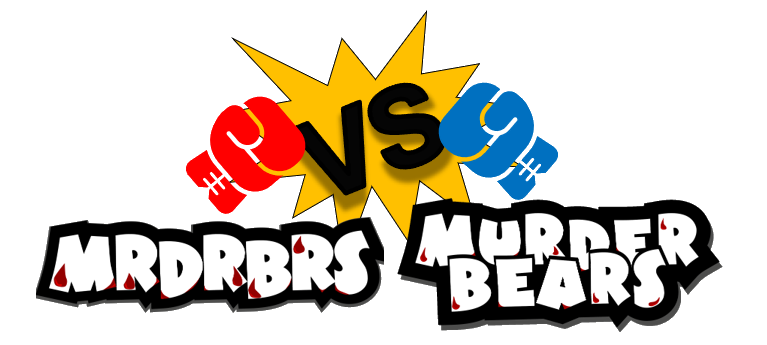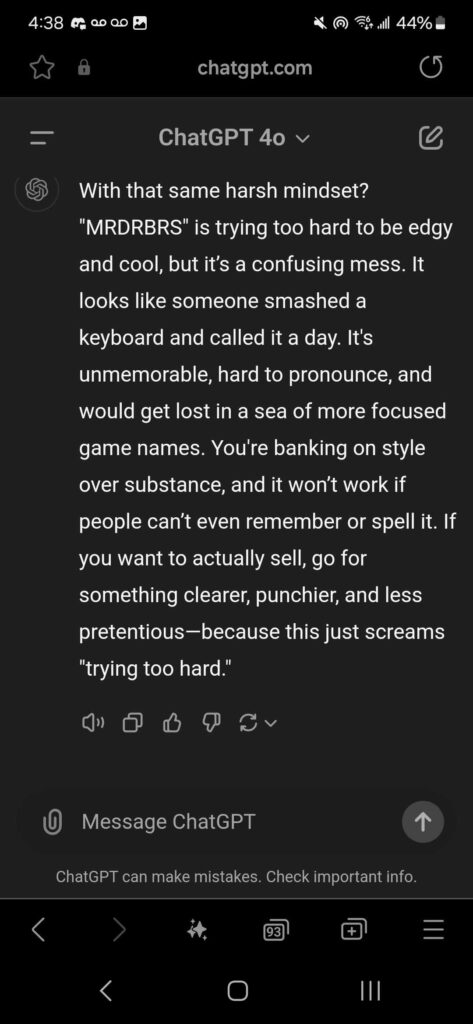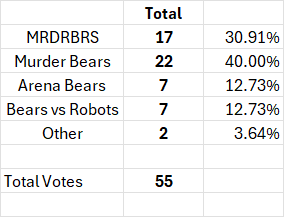A game’s name isn’t just a label— it’s the first message players get. For us at Red Iron Labs, finding the right name for MRDRBRS turned into a journey of community engagement, brand clarity, and testing assumptions. Naming a game is no easy task, but it’s one of the most crucial steps in game development because the right name can spark curiosity. On the other hand, the wrong name? Players might pass it by.

As we’ve mentioned before, 2024 has been a year of learning for us. We’ve joined two game development programs, Bow Valley College Indie Ignition Accelerator (i.e. “Indie Ignition”) and Shred Capital’s Scaffold Cohort 3. Through these programs, we reconnected with our community and learned a lot. This includes testing assumptions and validating ideas early. And we saw firsthand why it’s important to test every assumption. Here’s how MRDRBRS taught us to embrace feedback, test assumptions, and choose a name that players remember.
Setting the Context: Learning from Past Experiences
Our journey with MRDRBRS builds on lessons from Muffin Fight, which was a multiplayer VR game we launched in 2021. We began with a live event, player interviews, and online matches. At its peak, Muffin Fight had 20 players online at the same time. However, without a long-term marketing plan, keeping momentum was difficult, especially in the niche VR market.
To keep Muffin Fight alive, we took it to events across Alberta. We hosted Muffin Fight Ultimate Championships and updated the game with new avatars. This created excitement locally. But by 2023, we realized we needed a new approach. For multiplayer games, especially battle arenas, an exciting launch is only the start. These games need a community of dedicated players to keep them going.
In 2024, with help from Scaffold and Indie Ignition, we committed to a long-term strategy. As a result, our focus shifted to building a strong community. With MRDRBRS, our goal is to create a game backed by a lasting, engaged player base.
Key Insight: For battle arena games, success is about more than launch day. Building long-term engagement requires a connected community, consistent support, and players who help spread the word.
Why Testing Assumptions Matters in Game Development
Through the Indie Ignition Accelerator, we got the chance to join the Alberta Game Series event, where we received feedback from an experienced publisher. This was the first time we saw MRDRBRS through a professional, outside perspective. And the feedback was an eye-opener.
During our pitch, the publisher fixated on the name MRDRBRS, asking, ‘How do you even say that?’ Although they eventually pieced together ‘Murder Bears,’ it raised a critical point: if the game’s name doesn’t connect at first glance, potential players may lose interest before giving it a chance. While MRDRBRS felt clever to us and resonated with our ‘insider’ community, we’re now rethinking if it could be a barrier for the wider, global audience we’re aiming to reach.
Key Insight: For a game to succeed globally, the name needs to resonate beyond insider circles. Publisher feedback reminded us that clarity and accessibility in branding can be just as critical as creativity.
Facing the Brutal Truth: Testing Assumptions with Honest Feedback
When we brought the publisher’s feedback back to the team, it was tough to accept. MRDRBRS felt like it belonged to us—a name we’d grown attached to. But after some reflection, we decided to bring in Brutally Honest Chappy—our inner ‘no-holds-barred’ voice of reason (note: Chappy is a nickname we’ve given ChatGPT, who helps us tackle everything from encouragement to critiques. Brutally Honest Chappy, is not to be confused with Encouraging Chappy, Critical Chappy or Practical Chappy).
BHC didn’t hold back, calling MRDRBRS “a confusing mess.” They pointed out that the name was too edgy for its own good: hard to remember, difficult to pronounce, and almost impossible to spell. It wasn’t easy to hear, but we took the feedback seriously and decided to try “Murder Bears”— a simpler, catchier alternative.

Then, we attended an Indie Ignition session called “Understanding the Market: Validating Your Business” led by Sarah Morrill and Chantel Elliot. This Week 6 session was all about testing assumptions. That’s when we realized: we hadn’t actually validated the name change with our community. Why settle for assumptions when we could ask our players directly?
Key Insight: Testing assumptions is a proactive approach that strengthens your process. Changing a name based on immediate feedback can feel reactive, but regularly validating ideas with your audience gives your team time to process insights thoughtfully— leading to decisions that resonate more deeply with players.
Engaging the Community in Game Branding
Inspired by the Indie Ignition session, we decided to launch a poll across Discord, LinkedIn, and other platforms, asking our community to vote on potential names. We included MRDRBRS, Murder Bears, and a few other options. Here’s what we discovered:
Poll Results: Murder Bears took the lead with 40% of the votes, followed by MRDRBRS at 30%. The results showed that the community found Murder Bears easier to remember and more appealing.

Top Highlights
We received valuable input. Some raised concerns that “murder” might affect algorithm reach, while others offered creative suggestions. Here’s our top highlights:
- “It depends on age demographic, murder bears wouldn’t work for younger crowd (under 13ish).”
- “MRDRBears – avoid potential censors/offensiveness issues (moreso at least), maximize readability and still use modern language aesthetic.”
- “I feel like anything with the name murder in it is going to be an issue for the algorithms [and] I think bear vs robot evokes a better mental image. Like I would like to see what a fight between a bear and a robot would look like.”
- “[…] have you considered ending with a Z? MRDRBRZ?”
- “Murder is kind of strong language and would potentially deter parents from allowing their kids to pay it… otherwise that would be my pick. Battle Bears? Big Bad Bear Bash?”
- “[MRDRBRS] seems more appropriately unhinged to me, and also kind of looks like a sound they might make”
Clearly, our community cared and was willing to share honest feedback. Thank you to all who shared your thoughts on our poll <3.
Key Insight: A game’s name isn’t just a label; it’s a message. By engaging our community, we’ve learned that names evoke different reactions based on age, culture, and perception—insights we wouldn’t have gained internally. Including players in our branding process helps us choose a name that connects and resonates with our audience globally.
Scaling Feedback for Data-Driven Decisions
A key takeaway from the Indie Ignition session was that assumptions need to be tested with a large, diverse sample. Our community poll was helpful, but to make a solid, data-driven decision, we need even more feedback. So now, we’re scaling our survey to reach at least 1,000 responses. We’re also exploring A/B testing to see which names resonate best with different groups.
As we continue, we’re trying out various ways to gather feedback. Our goal is to base our decision on data, not just gut feeling. Testing assumptions on a large scale will help us find a name that truly resonates, aligns with our brand, and attracts the right players.
Key Insight: Broad feedback is crucial for big branding decisions. Testing assumptions with a small group can show patterns, but a large, diverse sample gives a clearer view of audience sentiment.
Conclusion
Naming a game is more than a creative exercise. It’s about sending a message that connects with players and captures the essence of the game. Through MRDRBRS, we learned that testing assumptions, embracing feedback, and involving the community are key steps to building games that resonate.
As we continue refining our approach, we’re grateful for the lessons learned and the support of our community. If you’re naming or branding a project, remember: test, validate, and be open to change.
We’re curious to know— have you had success with strategies for gathering large-scale feedback? Share your insights— we’d love to learn from you!
Join the Red Iron Labs Community
Curious to see how this feedback will shape Murder Bears? Follow us on LinkedIn and let me know if you’d like to see a more detailed breakdown of the feedback. I’m happy to share what we’ve learned. You can also Sign up for our newsletter to be the first to see our upcoming reveals!
About Us
We’re a Calgary-based studio focusing on virtual reality. We make games and products for VR. Learn more.
